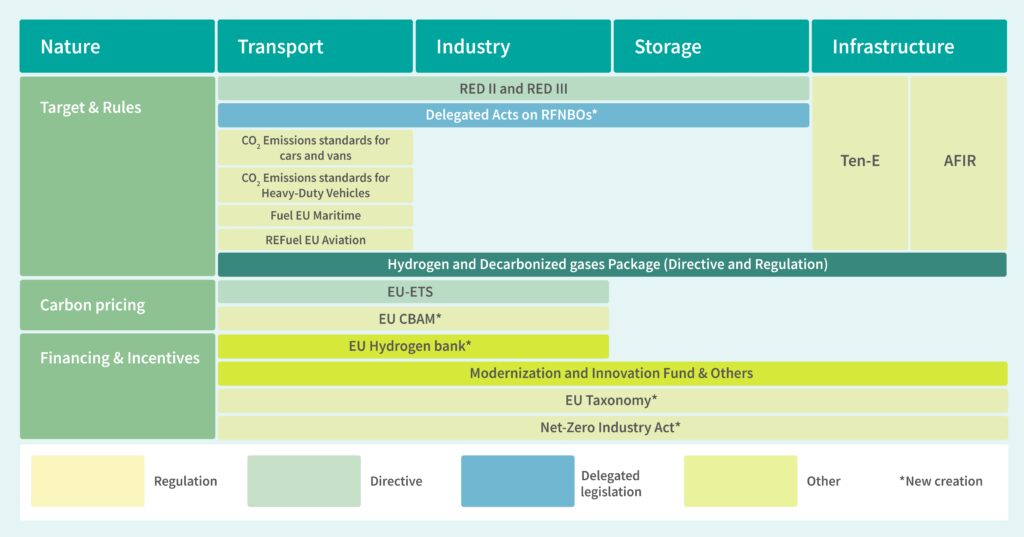After being proposed by EU Member States, Ursula von der Leyen has been reelected as President of the European Commission by the European Parliament on 18 July. What has she achieved in her first term and what are the to-dos for the next five years in relation to hydrogen and PtX?
Right at the beginning of her first mandate in 2019, Von der Leyen pledged to put forward a set of proposals for a European Green Deal within the first 100 days, including an European Climate Law setting a climate neutrality target for 2050. In December 2019 she delivered on her promise and in the communication for a European Green Deal, green hydrogen was already acknowledged as a priority area.
In July 2020, the European Commission published the European Hydrogen Strategy for a climate neutral Europe.
One year later in July 2021 the European Commission published the Fit for 55 package – a set of proposal to align EU´s energy and climate laws with the new objective of reducing net greenhouse gas emissions by at least 55% by 2030. Hydrogen, without being granted a specific regulatory vehicle, was integral part of most of the revised and new pieces of legislation.
Just before the end of the year 2021 the hydrogen and decarbonised gas market was published, establishing a strong framework for the development of the future hydrogen market, including for dedicated hydrogen infrastructure.
Although mot of EU laws have already been adopted, it is now time for implementing the different provisions, transpose directives into national law and publishing non-legislative acts which will supplement the existing framework. In other words, to transition from strategic planning to action. As an example the Renewable Energy Directive (RED III) which introduces targets for the use of RFNBOs in transport and industry (please see: Industry targets in European legislation for hydrogen and PtX products), should now be transposed into national law. Member States have until 21 May 2025 to do so and decide how RFNBOs targets will be achieved. While Regulations are directly applicable in its entirety across the EU, Directives must be transposed into national law by Member States which have some level of leeway to devise hot to achieve the stablished goals and targets.
The newly adopted EU regulatory framework for hydrogen is a complex combination of economic and legal instruments to fight climate change and support the energy transition, ranging from the establishment of binding targets rules and standards (i.a RED and Delegated Acts), putting a price on carbon emissions (EU ETS and CBAM) or establishing financial incentives (i.a. EU Hydrogen Bank):

While the previous Commission delivered on their original commitment of setting up a regulatory framework for hydrogen and derivatives, it is now time to assess whether this framework will support the market ramp-up and provide an economic viable pathway to reduce emissions in those sectors where direct electrification is not possible.
Von der Leyens speech before the European Parliament and the new Commission political guidelines give a first glance of how the ramp-up of PtX production should unfold:
- A Clean Industrial Deal to ensure sustainable growth and competitiveness for industry will be published within the first 100 days of her mandate:
- Enshrining a 90 % emission-reduction target in the EU climate law,
- Implementing the Fit for 55 package,
- Putting forward an Industrial Decarbonisation Accelerator Act, which will channel investment in infrastructure and industry, in particular for energy intensive sectors,
- Scaling up and prioritise investment in clean-energy infrastructure and technologies such as the deployment of a hydrogen network,
- Extend the aggregate demand mechanisms for gas to include hydrogen and critical raw materials,
- Stepping up EU green diplomacy and engage more with non-EU countries,
- Amending the CO2 standards for cars and vans by adopting a technology neutral approach where e-fuels should also play a role,
- Turbo charging investments:
- Putting forward a new European competitiveness fund as par to the new EU budget to reinforce investments in strategic technologies to facilitate the green transition
- A more strategic approach to the EU neighborhood with a focus on enlargement, investment partnerships, economic stability, energy and the Mediterranean (The latter will include a new Commissioner for the Mediterranean).
- New economic foreign policy and reshaping multilateralism . The three central pillars of the new economic foreign policy will be economic security, trade and investment partnerships.
- The EU-Partnership with Africa should drive investments in transport corridors, ports, renewable energy generation, green hydrogen production and raw material value chains.
- Deepen the cooperation between the EU and Latin America and the Caribbean from security to energy.
Next steps:
EU MS will nominate two candidates for Commissioners. The selection and composition of the new Cabinet is the prerequisite of the Commission President. The new elected Parliament will complement the Political Guidelines in September.
For further detailed information on the political guidelines please access:
Statement by candidate Ursula von der Leyen (europa.eu)
e6cd4328-673c-4e7a-8683-f63ffb2cf648_en (europa.eu)
